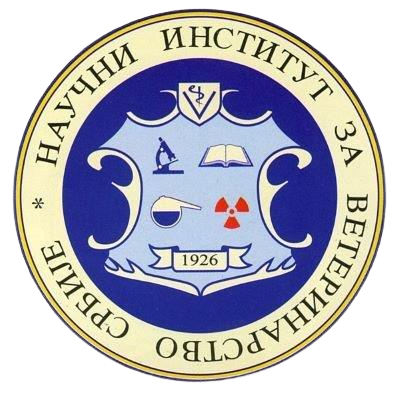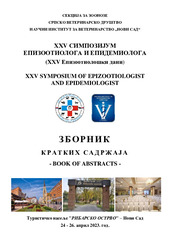Приказ основних података о документу
Parazitska fauna nutrija (Myocastor coypus) na teritoriji Republike Srbije
Parasitic fauna of nutria (Myocastor coypus) in the Republic of Serbia
| dc.creator | Vasić, Ana | |
| dc.creator | Kureljušić, Jasna | |
| dc.creator | Rokvić, Nikola | |
| dc.creator | Milovanović, Bojan | |
| dc.creator | Glišić, Dimitrije | |
| dc.creator | Radanović, Oliver | |
| dc.creator | Pavlović, Ivan | |
| dc.creator | Paunović, Milan | |
| dc.creator | Kureljušić, Branislav | |
| dc.creator | Milićević, Vesna | |
| dc.date.accessioned | 2023-07-28T07:53:15Z | |
| dc.date.available | 2023-07-28T07:53:15Z | |
| dc.date.issued | 2023 | |
| dc.identifier.isbn | 978-86-83115-48-8 | |
| dc.identifier.uri | https://reponivs.nivs.rs/handle/123456789/538 | |
| dc.description.abstract | Nutrije (Myocastor coypus) su invazivna južnoamerička vrsta velikih glodara čija je populacija na teritoriji Republike Srbije stabilna i brojna. Nekada gajeni zbog krzna, danas naseljavaju sve kontinente osim Okeanije i Antarktika. Nutrije žive na vlažnim staništima, uz obale većih reka i drugih vodenih površina. Iako su pretežno biljojedi, mogu ce hraniti i hranom životinjskog porekla, kao što su lešine, insekti, mali sisari i ptice, ribe i mekušci. U zemljama gde se koriste u ishrani ljudi opisani su slučajevi infekcije sa Trichinella spp. posle konzumiranja mesa nutrija. O prisustvu parazita kod nutrija postoje oskudni podaci iz literature, a među zabeleženim vrstama parazita po značaju se ističe Echinococcus multilocularis čija su rezervoarna vrsta u prirodi. Cilj našeg rada je bio da sagledamo parazitsku faunu nutrija Srbije, invazivne vrste o čijoj se biologiji i bolestima malo zna. Tokom 2022. i 2023. godine, legalno je izlovljen ukupno 101 primerak (15 juvenilnih, 8 subadulta i 78 adulta) nutrija, koje su dostavljene Odeljenju za patologiju Naučnog instituta za veterinarstvo Srbije. Spoljašnjim pregledom, nije utvrđeno prisustvo ektoparazita. Posle izvršene obdukcije, iz creva su izolovani adulti crevnih parazita i izvršena je morfološka identifikacija do nivoa roda i vrsta. Preliminarni rezultati su pokazali prisustvo unutrašnjih parazita kod 12 primeraka i to kod 11 adulta i 1 juvenilnog primerka. Morfološkom determinacijom ustanovljeno je prisustvo adulta Echinococcus multilocularis. Takođe, uzeti su uzorci jezika i/ili žvakaćih mišića od ukupno 90 nutrija radi pregleda na prisustvo larvi Trichinella spp. metodom veštačke digestije. Prisustvo larvi Trichinella spp. nije utvrđeno u pregledanim uzorcima. Po našem saznanju, ovo su prvi dokazi prisustva parazita Echinococcus multilocularis i odsustva larvi Trichinella spp. u populaciji nutrija u Republici Srbiji. Radi boljeg sagledavanja uloge ove vrste u prirodnim ciklusima parazita, potrebna su dalja istraživanja. | sr |
| dc.description.abstract | Nutria (Myocastor coypus) is an invasive rodent species native for South America, whose population is stable and numerous in the territory of the Republic of Serbia. This species has been bred by humans because of its fur for decades before it became widespread in all continents apart from Antarctic and Oceania. Nutria lives in wetlands, along the banks of larger rivers and other water bodies. Although they are predominately herbivores, they can also feed on food of animal origin, as carcasses, insects, small mammals and birds, fish or molluscs. In the countries where nutria is used as food, the infections of humans with Trichinella spp. were described. There is limited literature data on the presence of parasites in nutria, but with existing records on important parasites such as Echinococcus multilocularis for which nutria is reservoir species. The aim of our research was to get insight in the parasitic fauna of nutria in Serbia, an invasive species whose biology and diseases remain unstudied. During 2022 and 2023, total of 101 nutria specimens were legally hunted (15 juvenile, 8 subadults and 78 adults), and transported to Pathology department of the Scientific Veterinary Institute of Serbia. After outer inspection of the specimens no ectoparasites were found. After autopsy, from the intestine adult parasites were isolated and a morphological determination of species was performed. The parasites were found in 12 specimens from which 11 were adults and 1 was juvenile. Using morphological determination, the presence of adult Echinococcus multilocularis was established. Furthermore, samples of tongue and/or jaw musculature were taken from 90 specimens for the determination of presence of Trichinella spp. larvae using artificial digestion method. There was no Trichinella spp. present in our samples. To the best of our knowledge, these are the first evidence of Echinococcus multilocularis presence and Trichinella spp. absence in nutria population of Serbia. To better understand the role of this species in natural cycles of parasites, further research is needed. | sr |
| dc.language.iso | sr | sr |
| dc.language.iso | en | sr |
| dc.publisher | Beograd : Srpsko veterinarsko društvo, Sekcija za zoonoze | sr |
| dc.relation | info:eu-repo/grantAgreement/MESTD/inst-2020/200030/RS// | sr |
| dc.rights | openAccess | sr |
| dc.source | XXV Simpozijum epizootiologa i epidemiologa (XXV Epizootiološki dani) | sr |
| dc.subject | nutrija (Myocastor coypus) | sr |
| dc.subject | Trichinella spp. | sr |
| dc.subject | Echinococcus multilocularis | sr |
| dc.subject | Srbiija | sr |
| dc.subject | nutria (Myocastor coypus) | sr |
| dc.subject | Trichinella spp. | sr |
| dc.subject | Echinococcus multilocularis | sr |
| dc.subject | Serbia | sr |
| dc.title | Parazitska fauna nutrija (Myocastor coypus) na teritoriji Republike Srbije | sr |
| dc.title | Parasitic fauna of nutria (Myocastor coypus) in the Republic of Serbia | sr |
| dc.type | conferenceObject | sr |
| dc.rights.license | ARR | sr |
| dc.citation.epage | 77 | |
| dc.citation.spage | 76 | |
| dc.identifier.fulltext | http://reponivs.nivs.rs/bitstream/id/1258/bitstream_1258.pdf | |
| dc.type.version | publishedVersion | sr |

